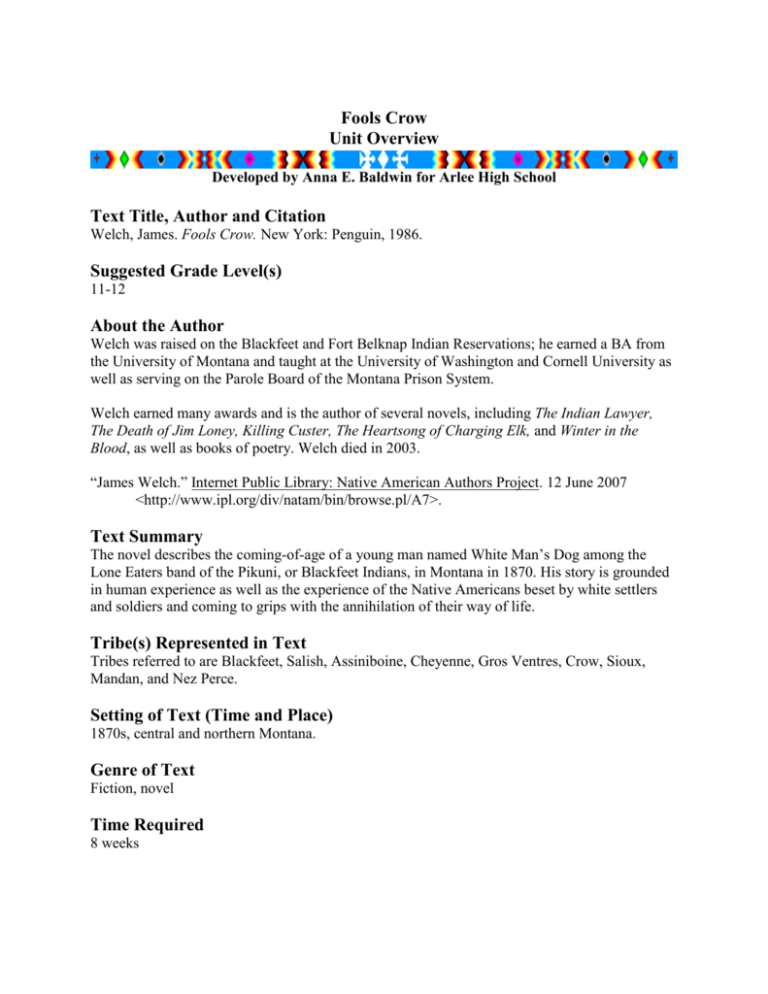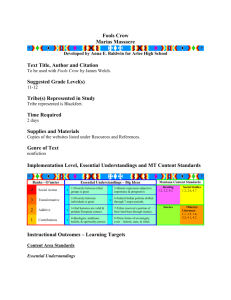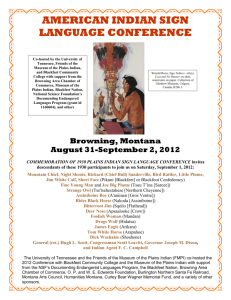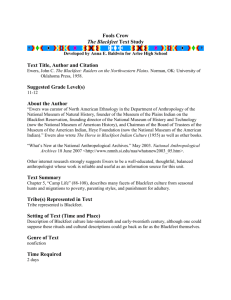Unit Overview - Arlee Joint School District No. 8
advertisement

Fools Crow Unit Overview Developed by Anna E. Baldwin for Arlee High School Text Title, Author and Citation Welch, James. Fools Crow. New York: Penguin, 1986. Suggested Grade Level(s) 11-12 About the Author Welch was raised on the Blackfeet and Fort Belknap Indian Reservations; he earned a BA from the University of Montana and taught at the University of Washington and Cornell University as well as serving on the Parole Board of the Montana Prison System. Welch earned many awards and is the author of several novels, including The Indian Lawyer, The Death of Jim Loney, Killing Custer, The Heartsong of Charging Elk, and Winter in the Blood, as well as books of poetry. Welch died in 2003. “James Welch.” Internet Public Library: Native American Authors Project. 12 June 2007 <http://www.ipl.org/div/natam/bin/browse.pl/A7>. Text Summary The novel describes the coming-of-age of a young man named White Man’s Dog among the Lone Eaters band of the Pikuni, or Blackfeet Indians, in Montana in 1870. His story is grounded in human experience as well as the experience of the Native Americans beset by white settlers and soldiers and coming to grips with the annihilation of their way of life. Tribe(s) Represented in Text Tribes referred to are Blackfeet, Salish, Assiniboine, Cheyenne, Gros Ventres, Crow, Sioux, Mandan, and Nez Perce. Setting of Text (Time and Place) 1870s, central and northern Montana. Genre of Text Fiction, novel Time Required 8 weeks Supplies and Materials Fools Crow, a copy for every student Implementation Level, Essential Understandings and MT Content Standards Banks - O’meter Essential Understandings – Big Ideas 4 Social Action x 1-Diversity between tribal groups is great. x 5-History represents subjective experience & perspective. 3 Transformative x 2-Diversity between individuals is great. x 6-Federal Indian policies shifted through 7 major periods. 2 Additive x 3-Oral histories are valid & predate European contact. 7-Tribes reserved a portion of their land-base through treaties. 1 Contributions x 4-Ideologies, traditions, beliefs, & spirituality persist 8-Three forms of sovereignty exist – federal, state, & tribal. Montana Content Standards Reading 1.1-1.5, 2.22.4, 2.8, 4.2, 4.3, 4.5, 4.7, 5.1, 5.2, 5.4 Social Studies 1.1, 1.2, 2.2, 2.6, 3.1, 3.2, 4.2, 4.7, 5.4, 6.2, 6.4, 6.5 Science Other(s) Literature 1.11.6, 2.1, 2.4, 3.2, 4.1-4.4, 5.3, 5.4 Writing 1.11.4, 2.1-2.5, 4.3 Library Media 1.1, 1.5, 2.2, 4.2, 4.3 Instructional Outcomes – Learning Targets Content Area Standards Essential Understandings Essential Understanding 1: There is great diversity among the 12 tribal Nations of Montana in their languages, cultures, histories and governments. Each Nation has a distinct and unique cultural heritage that contributes to modern Montana. Essential Understanding 2: There is great diversity among individual American Indians as identity is developed, defined and redefined by many entities, organizations and people. There is a continuum of Indian identity ranging from assimilated to traditional and is unique to each individual. There is no generic American Indian. Essential Understanding 3: The ideologies of Native traditional beliefs and spirituality persist into modern day life as tribal cultures, traditions and languages are still practiced by many American Indian people and are incorporated into how tribes govern and manage their affairs. Additionally, each tribe has its own oral history beginning with their origins that are as valid as written histories. These histories pre-date the “discovery” of North America. Essential Understanding 5: History is a story and most often related through the subjective experience of the teller. Histories are being rediscovered and revised. History told from an Indian perspective conflicts with what most of mainstream history tells us. Essential Understanding 6: There were many federal policies put into place throughout American history that have impacted Indian people and shape who they are today. Much of Indian history can be related through several major federal policy periods. Social Studies Students will 1.1 analyze and adapt an inquiry process (i.e., identify question or problem, locate and evaluate potential resources, gather and synthesize information, create a new product, and evaluate product and process). 1.2 apply criteria to evaluate information (e.g., origin, authority, accuracy, bias, and distortion of information and ideas). 2.2 differentiate and analyze the relationships among various regional and global patterns of geographic phenomena (e.g., land forms, soils, climate, vegetation, natural resources, population). 2.6 analyze and evaluate conditions, actions and motivations that contribute to conflict and cooperation within and among groups and nations (e.g., current events from newspapers, magazines, television). 3.1 interpret, use, and synthesize information from various representations of the Earth (e.g., maps, globes, satellite images, geographic information systems, three-dimensional models). 3.2 differentiate and analyze the relationships among various regional and global patterns of geographic phenomena (e.g., land forms, soils, climate, vegetation, natural resources, population). 4.2 interpret how selected cultures, historical events, periods, and patterns of change influence each other. 4.7 analyze and illustrate the major issues concerning history, culture, tribal sovereignty, and current status of the American Indian tribes and bands in Montana and the United States (e.g., gambling, artifacts, repatriation, natural resources, language, jurisdiction). 5.4 compare and contrast how values and beliefs influence economic decisions in different economic systems. 6.2 analyze human experience and cultural expression (e.g., language, literature, arts, traditions, beliefs, spirituality, values, behavior) and create a product which illustrates an integrated view of a specific culture. 6.4 evaluate how the unique characteristics of American Indian tribes and other cultural groups have contributed to Montana’s history and contemporary life (e.g., legal and political relationships between and among tribal, state, and federal governments). 6.5 analyze the conflicts resulting from cultural assimilation and cultural preservation among various ethnic and racial groups in Montana, the United Sates and the world. Skill Sets Reading Students will 1.1 make predictions and describe inferences and connections within material and between new material and previous information/experiences. 1.2 integrate new important print/nonprint information with existing knowledge to draw conclusions and make application. 1.3 provide oral, written, and/or artistic responses to ideas and feelings generated by the reading material, providing examples of the way these influence one’s life and role in society. 1.4 demonstrate understanding of main ideas and formulate arguments using supporting evidence. 1.5 accurately paraphrase reading material, reflecting tone and point of view. 2.2 identify, analyze and evaluate literary elements. 2.3 identify, analyze and evaluate the use of literary devices. 2.4 use features and organization of fiction and nonfiction materials to comprehend increasingly complex material (e.g., paragraphs, chapters, titles, indexes, tables of contents, graphs, charts, visuals, and methods of organization). 2.8 ask questions, check predication, summarize, and reflect on information to monitor progress while taking responsibility for directing one’s own reading. 4.2 read to evaluate appropriate resource material for a specific task. 4.3 locate, read, analyze, and interpret material to investigate a question, topic, or issue. 4.4 read, analyze, and synthesize information to perform complex tasks for a variety of purposes. 4.5 read and analyze works of various authors. 4.6 read, evaluate and create material and documents related to social and civic responsibilities. 4.7 locate, read, analyze, and evaluate information from a variety of sources. 5.1 compare and contrast information and broad themes within and among a variety of information sources. 5.2 logically synthesize information from a complex range of print and nonprint sources. 5.3 analyze use of evidence, logic, language devices, and bias as strategies to influence readers. 5.4 analyze use of evidence, logic, language devices, and bias as strategies to influence readers. Literature Students will 1.1 propose and pursue questions and answers to the complex elements of literary works. 1.2 develop and define with textual support interpretations of complex literary works. 1.3 analyze the major elements significant to the interpretation process (e.g., point of view, tone, dramatic action). 1.4 recognize, compare, contrast, make connections, and analyze approaches to literary elements in various works. 1.5 compare and contrast individual and group responses/reactions with author’s purpose/intent. 1.6 demonstrate oral, written, and/or artistic responses to ideas and feelings generated in literary works. 2.1 discuss ways in which literary devices and elements (e.g., syntax, imagery, figurative language, allusion, symbols, irony) produce a dominant tone, effect or theme. 2.4 evaluate how language, literary devices, and forms contribute to the impact of a work on the reader/listener/viewer. 3.2 develop and apply criteria to evaluate the reliability, authenticity, and literary merit of information conveyed in a literary work. 4.1 select, read, listen to, and view a variety of traditional and contemporary works from diverse cultures, genders, genres, historical periods, and styles. 4.2 demonstrate how factors of history and culture, gender and genre, influence and give meaning to literature. 4.3 create and share responses to literary works. 4.4 analyze diverse literature to identify and compare common human experiences within and between cultures. 5.3 recognize patterns, symbols, and universal themes present across literary works and relate those to personal experiences. 5.4 investigate and report ways in which authors, their works, and their styles have impacted or been influenced by social and cultural issues or events. Library Media Students will 1.1 analyze and adapt the inquiry process to satisfy individual and group information needs (i.e., identify the question or problem, locate and evaluate potential resources, gather and synthesize information, create a new product, and evaluate the product and process). 1.5 synthesize information to create a new product that meets a specific purpose or vision. 2.2 use information in an ethical manner by adhering to copyright laws, requesting permission to use information, and properly citing sources. 4.2 develop and demonstrate research strategies to effectively locate information in various media and technologies. 4.3 generate and apply criteria to evaluate the origin, authority, accuracy, bias, and distortion of information from a variety of media and technologies. Writing Students will 1.1 organize text in paragraphs with clear beginning, middle, and end, using effective transitions and logical sequence. 1.2 develop and elaborate main ideas through relevant and specific supporting details. 1.3 demonstrate purposeful control of personal voice, sentence structure, and word choice. 1.4 apply conventions of standard written English appropriate for grade level and purpose. 2.1 plan writing by generating ideas through a variety of strategies, and organizing by analyzing purpose and audience. 2.2 write one or more drafts that capture, explore, and organize ideas. 2.3 revise writing by seeking feedback from others and making appropriate changes to improve text. 2.4 edit by correcting errors. 2.5 share/publish a legible final product. Learning Experiences – Text-Based Inquiry Unit Before Poetry Immersion Activity using James Welch’s Riding the Earthboy 40 Text Study using The Blackfeet by John C. Ewers During Sun Dance Study Marias Massacre After “Shadow of a Nation” Text Study Assessment Teacher-made test (not provided in this unit) Suggested Day-By-Day Plan Reading schedule: 2 chapters per week plus 2 chapters due on Mondays. Teacher Notes and Cautions This novel has been challenged in several towns and states across the nation and is on the American Library Association’s list of Challenged Books (“Banned.”) Some reasons for challenges include its “graphic descriptions of rape, mutilation, and murder” (Schontzler). However, “supporters of the book say its literary value - specifically its insights into American Indian society and Montana history - outweighs the controversial passages” (Listoe). “Banned Books.” Fall 2004. American Library Association. 19 June 2007 <http://www.ala.org/ala/oif/bannedbooksweek/bannedbooks.pdf>. Listoe, Alana. “Woman wants book removed from school.” 13 Apr. 2007. Helena Independent Record. 19 June 2007 <http://www.helenair.com/articles/2007/04/13/helena/000book.txt>. Schontzler, Gail. “Bozeman dad challenges ‘Sex God’ book over title.” 18 June 2007 <www.kidspeakonline.org/sexgod.htm>. Welch, James. Fools Crow. New York: Penguin, 1986.










